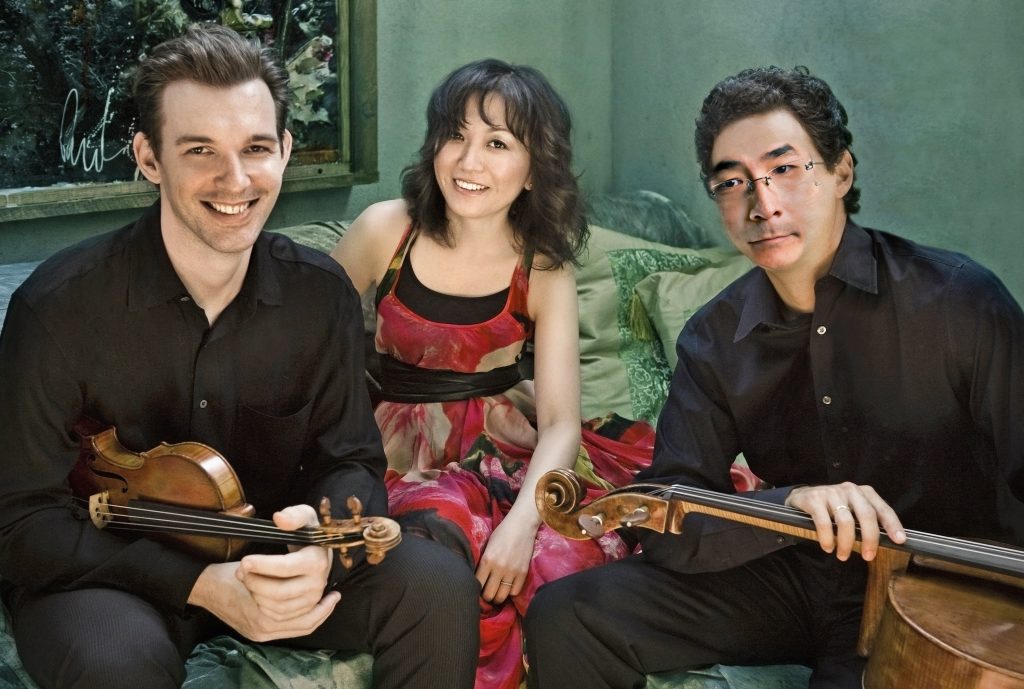
Morton Feldman’s “beauty of a lone voice” and John Cage’s “stripped-down energy” from a toy piano met oddly side by side with Grieg and Schumann piano trios, as the Horszowski Trio again pursued a COVID theme, “In the Face of Isolation II,” at Longy School of Music Friday night.
Explicating their theme, “Grieg composed in an isolated cottage,” and Schumann “suffered from a mental illness, the pain he felt was powerful, but he was able to channel it and bring us into his own world of fantasy and emotion.”
How did this thematic thinking by the Trio ultimately work out in Pickman Hall? Two shows in one. Slotted in between break out renderings of the Europeans came a meditative offering of the 20th century avant-garde Americans, as Longy’s lights dimmed. A year ago the Horszowski Trio, in residence at the school, had tendered one of Feldman’s two-hour pieces for their “Isolation I” concert.
Grieg’s Andante Con Moto in C Minor for Piano Trio (1878) was discovered posthumously by Grieg’s close friend, Julius Röntgen who wrote: “How he can’t get enough of that single theme…” Others have described the late work as abstemious or ascetic. Wouldn’t these observations be more pertinent than an account of the composer’s working alone in a small house? Disconcertingly, Horszowski Trio redirected the Andante con moto along sharp-edged, quick-tempered lines. Dramatized contrasts morphed a bit too blatantly throughout.
Longy’s spotlights then focused alternately on the players. Etude no. 5 for solo piano “Rain At Funeral–Homage to Morton Feldman” (2005), a late addition to the concert, ran at odds with the meditative design of the middle portion. Pianist Rieko Aizawa accentuated both the low-chiming chords and searing treble tones.
While Aizawa played, the violinist and cellist remained on stage at either side of the Steinway and a toy piano. Ole Akahoshi opened Feldman’s Projection 1 for solo cello (1950) with an attention prompting plucked note. An array of delicate sounds—75—followed, each with its requisite silence. Jesse Mills continued in a similar disposition with For Aaron Copland for solo violin (1981). The homage spoke with more softness and a bit more linearity. Surprisingly, an expressive albeit tiny melody materialized midway among the 100 individual sounds.
During the silences, the 30-plus socially distanced listeners, aside for a single muffled cough, were pin-drop-quiet.

Tiny bell-like sounds issued forth in Cage’s Suite for Toy Piano (1948). Aizawa starred in her limited role. She zoned in with finely tailored phrases, crisped repeating keys, and a toy-like expressiveness that endeared.
A jarring shift from America back to Europe brought Schumann’s Piano Trio no. 1 in D Minor, Op. 63 (1847). Could the trio have offered that work, as well as Grieg’s, in some manner which better reinforced their theme? Reviews of the ensemble point out its power and its accomplishments. Still young, the ensemble has time to develop further and mature. While technical refinement and plenteousness of emotive engagement obtained throughout, the group mostly missed the big picture. It wasn’t that the Trio overstepped Schumann’s directions for the first movement Mit Energie und Leidenschaft. Rather, they seemed insensitive to how both Schumann and Grieg structured their work around harmony. That dimension offers abundant clues for elucidation. For the less complex second and fourth movements, it became more apparent that the players diverged, often in indirect or nuanced ways, from one another’s voicings.
The handout explained that the group “…takes its inspiration from the musicianship, integrity, and humanity of the preeminent pianist Mieczyslaw Horszowski (1892-1993); the ensemble’s pianist, Rieko Aizawa, was Horszowski’s last pupil at the Curtis Institute.


